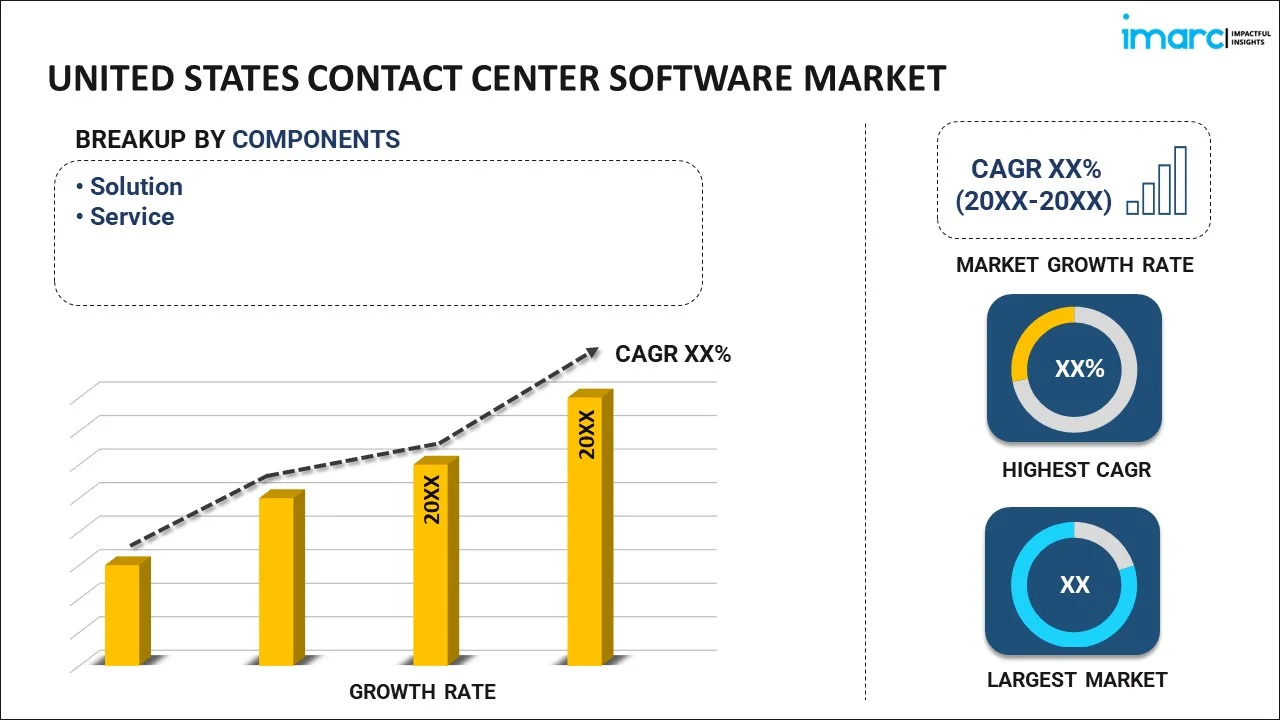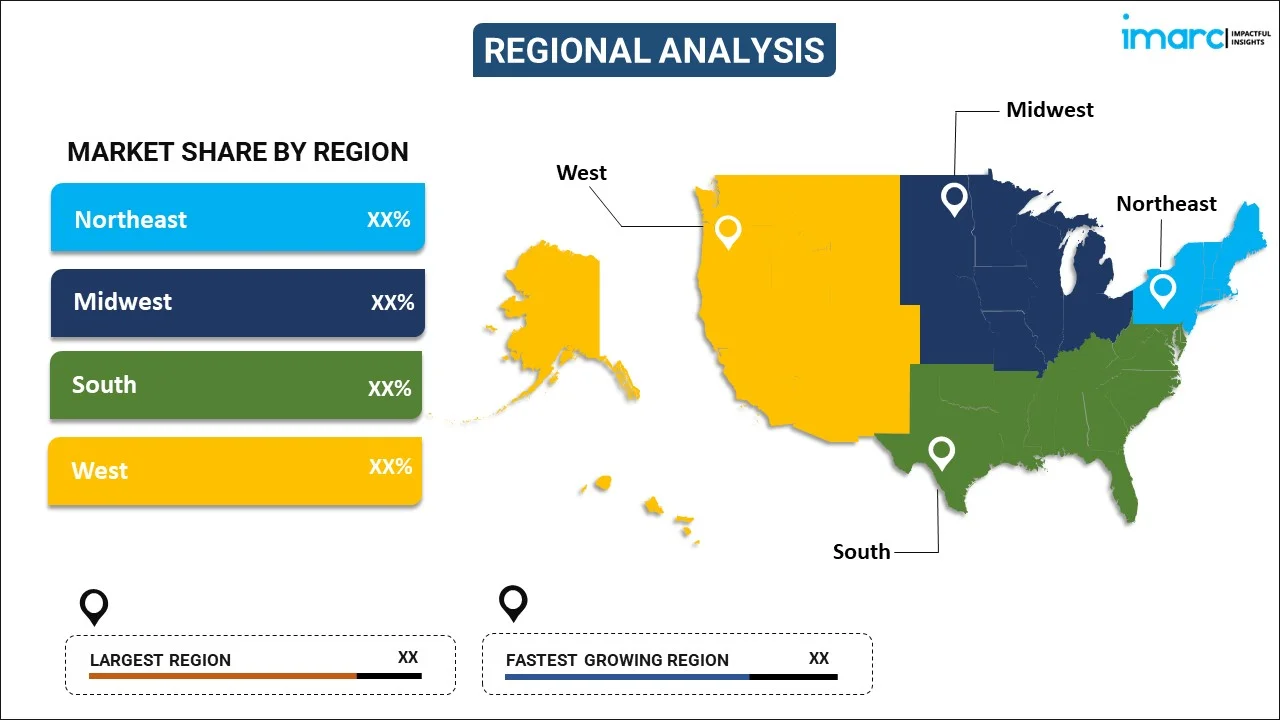
United States Contact Center Software Market Report by Component (Solution, Service), Deployment Mode (On-premises, Cloud-based), Enterprise Size (Large Enterprises, Small and Medium-sized Enterprises), End Use (BFSI, Consumer Goods and Retail, Government, Healthcare, IT and Telecom, Travel and Hospitality, and Others), and Region 2026-2034
Market Overview:
United States contact center software market size reached USD 11.6 Billion in 2025. Looking forward, IMARC Group expects the market to reach USD 39.4 Billion by 2034, exhibiting a growth rate (CAGR) of 14.58% during 2026-2034. The increasing utilization of contact center software in manufacturing and utilities for predictive maintenance, rising adoption of remote work modules, and the incorporation of various tools in contact center software for mapping and analyzing customer journeys represent some of the key factors driving the market.
|
Report Attribute
|
Key Statistics
|
|---|---|
|
Base Year
|
2025
|
|
Forecast Years
|
2026-2034
|
|
Historical Years
|
2020-2025
|
|
Market Size in 2025
|
USD 11.6 Billion |
|
Market Forecast in 2034
|
USD 39.4 Billion |
| Market Growth Rate 2026-2034 | 14.58% |
Access the full market insights report Request Sample
Contact center software refers to a suite of digital tools and technologies designed to facilitate communication between customers and the agents or representatives of a company. It acts as a centralized hub for handling customer inquiries, resolving issues, and providing support across multiple communication channels. It accommodates various communication channels such as voice calls, emails, live chat, SMS, and social media, ensuring flexibility and convenience for customers. It routes incoming calls to the most appropriate agent based on factors like skill level, availability, or customer history, reducing wait times and improving service quality. It can adapt to changing business needs, allowing companies to expand or contract their customer service operations as required. It is widely used in industries such as e-commerce, telecommunications, and financial services to provide customers with assistance, troubleshoot problems, and address inquiries. Moreover, it can also support market research efforts by collecting feedback, conducting surveys, and gauging customer sentiment. Besides this, as it allows businesses to serve customers who speak different languages, broadening their customer base, the demand for contact center software is increasing across the United States.
United States Contact Center Software Market Trends:
Rapid industrialization in the United States and the increasing utilization of contact center software in manufacturing and utilities for predictive maintenance represent one of the primary factors facilitating the market growth. Along with this, the rising adoption of remote work modules in the country is driving the demand for contact center software to support virtual agent training and onboarding. Apart from this, various contact center software providers are offering environment friendly options, such as energy-efficient data centers and reduced carbon footprint solutions, to attract a wider consumer base. Furthermore, the increasing influence of social media platforms is strengthening the growth of the market. Contact center software now includes features for social listening and sentiment analysis, allowing businesses to monitor online conversations and respond proactively to brand mentions or customer feedback. Moreover, the incorporation of various tools in contact center software for mapping and analyzing customer journeys is helping companies identify pain points and opportunities for improvement. In line with this, the integration of automation features that help businesses stay compliant by recording and archiving interactions, managing consent, and providing audit trails is driving the market. Besides this, the integration of artificial intelligence (AI) and chatbot technology is driving the adoption of contact center software. AI-powered chatbots can handle routine customer inquiries, provide quick responses, and assist with basic problem-solving. In line with this, businesses in the United States are increasingly leveraging AI-driven analytics to gain insights from customer interactions, enhance personalization, and identify trends for better decision-making.
United States Contact Center Software Market Segmentation:
IMARC Group provides an analysis of the key trends in each segment of the market, along with forecasts at the country level for 2026-2034. Our report has categorized the market based on component, deployment mode, enterprise size, and end use.
Component Insights:

To get detailed segment analysis of this market Request Sample
- Solution
- Automatic Call Distribution (ACD)
- Call Recording
- Computer Telephony Integration (CTI)
- Customer Collaboration
- Dialer
- Interactive Voice Responses (IVR)
- Others
- Service
- Integration and Deployment
- Support and Maintenance
- Training and Consulting
- Managed Services
The report has provided a detailed breakup and analysis of the market based on the component. This includes solution (automatic call distribution (ACD), call recording, computer telephony integration (CTI), customer collaboration, dialer, interactive voice responses (IVR), and others) and service (integration and deployment, support and maintenance, training and consulting, and managed services).
Deployment Mode Insights:
- On-premises
- Cloud-based
A detailed breakup and analysis of the market based on the deployment mode have also been provided in the report. This includes on-premises and cloud-based.
Enterprise Size Insights:
- Large Enterprises
- Small and Medium-sized Enterprises
The report has provided a detailed breakup and analysis of the market based on the enterprise size. This includes large enterprises and small and medium-sized enterprises.
End Use Insights:
- BFSI
- Consumer Goods and Retail
- Government
- Healthcare
- IT and Telecom
- Travel and Hospitality
- Others
A detailed breakup and analysis of the market based on the end use have also been provided in the report. This includes BFSI, consumer goods and retail, government, healthcare, IT and telecom, travel and hospitality, and others.
Regional Insights:

To get detailed regional analysis of this market Request Sample
- Northeast
- Midwest
- South
- West
The report has also provided a comprehensive analysis of all the major regional markets, which include Northeast, Midwest, South, and West.
Competitive Landscape:
The market research report has also provided a comprehensive analysis of the competitive landscape. Competitive analysis such as market structure, key player positioning, top winning strategies, competitive dashboard, and company evaluation quadrant has been covered in the report. Also, detailed profiles of all major companies have been provided.
United States Contact Center Software Market Report Coverage:
| Report Features | Details |
|---|---|
| Base Year of the Analysis | 2025 |
| Historical Period | 2020-2025 |
| Forecast Period | 2026-2034 |
| Units | Billion USD |
| Scope of the Report | Exploration of Historical and Forecast Trends, Industry Catalysts and Challenges, Segment-Wise Historical and Predictive Market Assessment:
|
| Components Covered |
|
| Deployment Modes Covered | On-premises, Cloud-based |
| Enterprise Sizes Covered | Large Enterprises, Small and Medium-sized Enterprises |
| End Uses Covered | BFSI, Consumer Goods and Retail, Government, Healthcare, IT and Telecom, Travel and Hospitality, Others |
| Regions Covered | Northeast, Midwest, South, West |
| Customization Scope | 10% Free Customization |
| Post-Sale Analyst Support | 10-12 Weeks |
| Delivery Format | PDF and Excel through Email (We can also provide the editable version of the report in PPT/Word format on special request) |
Key Questions Answered in This Report:
- How has the United States contact center software market performed so far and how will it perform in the coming years?
- What has been the impact of COVID-19 on the United States contact center software market?
- What is the breakup of the United States contact center software market on the basis of component?
- What is the breakup of the United States contact center software market on the basis of deployment mode?
- What is the breakup of the United States contact center software market on the basis of enterprise size?
- What is the breakup of the United States contact center software market on the basis of end use?
- What are the various stages in the value chain of the United States contact center software market?
- What are the key driving factors and challenges in the United States contact center software?
- What is the structure of the United States contact center software market and who are the key players?
- What is the degree of competition in the United States contact center software market?
Key Benefits for Stakeholders:
- IMARC’s industry report offers a comprehensive quantitative analysis of various market segments, historical and current market trends, market forecasts, and dynamics of the United States contact center software market from 2020-2034.
- The research report provides the latest information on the market drivers, challenges, and opportunities in the United States contact center software market.
- Porter's five forces analysis assist stakeholders in assessing the impact of new entrants, competitive rivalry, supplier power, buyer power, and the threat of substitution. It helps stakeholders to analyze the level of competition within the United States contact center software industry and its attractiveness.
- Competitive landscape allows stakeholders to understand their competitive environment and provides an insight into the current positions of key players in the market.
Need more help?
- Speak to our experienced analysts for insights on the current market scenarios.
- Include additional segments and countries to customize the report as per your requirement.
- Gain an unparalleled competitive advantage in your domain by understanding how to utilize the report and positively impacting your operations and revenue.
- For further assistance, please connect with our analysts.
 Request Customization
Request Customization
 Speak to an Analyst
Speak to an Analyst
 Request Brochure
Request Brochure
 Inquire Before Buying
Inquire Before Buying




.webp)




.webp)












